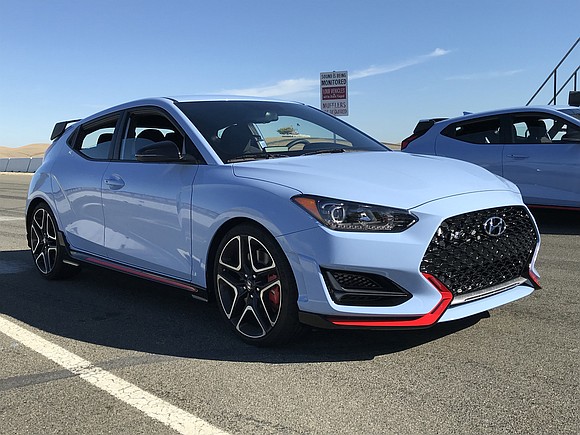AboutThatCar.com: 2019 Hyundai Veloster N
Style Magazine Newswire | 11/5/2018, 11:38 a.m.
By Frank S. Washington
SACRAMENTO, Calif., – We came here to test drive the next step in Hyundai’s future, the 2019 Veloster N. As one executive said, “it is a racing car that we’re trying to sell to the public.”
What Hyundai is also doing is expanding and redefining its brand. The N logo is for the Korean automaker’s high performance models. Right now there are three: one is sold in Europe, one is sold in South Korea and the U.S. edition will be on sale by the end of the year.
And let’s be clear, the N brand is more than a body kit. Hyundai didn’t create new parts but they took what was on their shelves and re-engineered the heck out of it.
What they’ve got is a high performance Veloster that has a 2.0-liter turbocharged four-cylinder engine that makes 250 horsepower and 260 pound-feet of torque. Get this; when equipped with the optional performance package, engine output is upped to 275 horsepower with the same 260 pound-feet of torque from 1,450 thru 4,700 rpm.
It was mated to a close-ratio, short-throw six-speed manual transmission with downshift rev-matching capability. The transmission used carbon-coated synchro rings and gear material reinforcement for smoother operation and lower overall shift force coupled with a positive engagement feel.
A dual-clutch automatic transmission is in development but it is two years away from being introduced. However, I found the six-speed manual more than worthy of the powerhouse engine of the 2019 Veloster N. Gearshifts were precise, it was not clunky like you find on a lot of short throw manuals and down shifts were smooth.
The turbo system intercooler was isolated from the condenser and radiator for more efficient cooling of the intake charge. The setup also benefited from a two-stage induction system for maximum output at all rpm ranges. The engine compression ratio is 9.5:1, which was high, Hyundai said, for a turbocharged engine.
There was a multi-mode, high-flow active sport exhaust system with a variable exhaust actuator. In N mode, this system yielded an over-run exhaust crackle during spirited-driving upshifts and rev-matched downshifts. This exhaust system was further augmented with an electronic sound generator that enhanced the natural powertrain sound. Fuel economy for the Veloster N is an estimated 22 mpg in the city, 28 mpg on the highway and 25 mpg combined.
The Veloster N had an exclusive front fascia with dedicated air ducts for better brake cooling. There were LED headlights, N-design rocker side sills and available 19-inch alloy wheels with a dual spoke design; 18-inch wheels are standard.
The 19-inch wheels which we had were shod with 235/35R19 Pirelli P-Zero performance tires.
The rear of the Veloster N had a large spoiler, a rear fascia design with integrated diffuser, and a performance-diameter high-flow dual exhaust. There were also LED tail lamps. The car will be available in four colors: racing red, chalk white, performance blue (exclusive to the model) and phantom black.
I think the most distinctive enhancement on the exterior of the Veloster N was a red accent stripe that encircled the bottom of the car and accentuated the lower part of the grille frame.
On the inside, the 2019 Hyundai Veloster N had exclusive N-design front cloth sport seats with performance-focused bolstering, an N-design steering wheel, shift knob, N-logo door sill plates, and N-design electroluminescent instrument cluster.
The interior design was accentuated by an N performance blue accent theme. As engine speed approached redline, the N-design center cluster displayed a progressive sequential shift indicator, which with my eyes glued to the road I never saw, alerting the driver of an impending shift point for maximum acceleration. N-brand metallic door sill scuff plates greet the driver and passenger as they approach the front seats.
This was not the average press launch. It was heavy on track driving. We drove other Hyundai vehicles to Thunderhill Raceway Park in Willows about 86 miles northwest from here.
The racetrack was three miles of tight turns, there were 13, blind rises and a couple of decent straightaways. The course revealed the acceleration prowess of the Veloster N as well as its steering. On the straights, I got up to 80 mph without really trying for maximum speed.
My heart did start beating faster while on the track not because of fear but due to the fun I was having. That’s what Hyundai engineers were after; fun without fear. But that is on a track. For the streets there were three driving modes: normal, sport and N.
Hyundai did a lot of work on the powertrain bushings to handle downshifting from higher speeds. This was a front-wheel drive car and I felt no torque steer either, they worked on that too.
There was a slalom set up in one of the parking lots. The course was not that long, most drivers got through it in roughly 40 seconds. It was a test of acceleration, braking and quick cornering.
The whole outing was a challenge for suspension geometry and tuning. Hyundai said the Veloster N’s Power Sense Axle geometry featured a zero-scrub radius for more precise steering, quicker response, and a direct on-center feel, with increased steering linearity. The geometry was further optimized for linear torque build up and corner-exit precision. Roll angle was also decreased due to a shorter roll-moment arm that resulted in enhanced grip.
The motor-driven power steering system was rack-mounted and secured at three locations for reduced flex and more direct handling, especially during high-performance driving. Unique suspension tuning was derived from a multi-mode electronically-controlled suspension with the track-focused N mode available. The suspension used a load-transfer control system that reduced dive during braking, enhanced roll control during cornering and reduced rear suspension compression under hard acceleration.
One must of going fast is being able to stop quickly when and if needed. The Veloster N offered available oversized 13.6-inch performance rotors on the front axle and 12.4-inch rotors on the rear, for confident, heat-dissipating braking performance coupled with a firm pedal feel. Standard Veloster N brake rotors are 13.0 inches in the front and 11.8 inches in the rear.
But let’s face it, although the 2019 Veloster N is a low volume car with road track pedigree, it will probably be driven mostly on the street. That was the third leg of this test.
I took a right coming out of the raceway onto Highway 162 and was on an aggregate packed rural stretch of road for five miles. The road noise was stunningly loud. And the P Zero Pirelli summer tires didn’t help.
Then the road surface changed to black top which looked new and it was like night and day. There was no road noise. All I heard was the wind gently going over the roof and around the mirrors.
This highway was a two lane affair with sweeping curves through rolling hills where the deep tan foliage was in need of rain. It was the kind of place that had a 55 mph speed limit but it was easy to do 80 mph. The Veloster N tracked well, stayed planted on the road, there wasn’t any wavering and I could have easily done 100 mph through here. But I remained reserved. The car seemed like an easy street driver.
In other words, the 2019 Hyundai Veloster N was a great track car that had city street chops. Best of all is, though prices had not been finalized at the time of the test drive, the 250 horsepower model will cost less than $28,000, while the 275 horsepower Veloster N will be less than $30,000.
Frank S. Washington is editor of AboutThatCar.com






